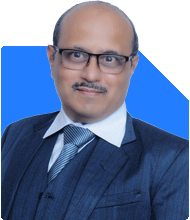I'm 29, making 43k a month and investing. How can I save more?
Ramalingam Kalirajan |10893 Answers |Ask -Follow
Mutual Funds, Financial Planning Expert - Answered on Nov 26, 2024
He has an MBA in finance from the University of Madras and is a certified financial planner.
He is the director and chief financial planner at Holistic Investment, a Chennai-based firm that offers financial planning and wealth management advice.... more

I am 29 years old and working in a steel plant. I got 43,000 per month in hand as my salary. I have mutual funds of 10,500 in 5 different AMC and one recurring deposit of 3000. What should I do if I want to save more? Please advice
Key Financial Considerations
Emergency Fund:
Maintain an emergency fund of 6 months' expenses. This fund should be in a liquid asset, such as a savings account or liquid mutual fund. It will help manage unexpected expenses without disturbing your investments.
Existing Investments:
Your mutual fund SIPs of Rs 10,500 across five AMCs may lack focus. Investing in too many schemes may dilute returns and create portfolio overlap. Consolidate to a few quality schemes managed by experienced fund managers.
Recurring Deposit:
While RDs are safe, they offer limited growth potential compared to mutual funds. Evaluate the purpose of this RD. If it's not meant for short-term goals, consider redirecting it into equity or hybrid funds for higher returns over time.
Setting Clear Financial Goals
Define your short-term (1–3 years), medium-term (3–7 years), and long-term goals (7+ years).
Short-term goals can be handled using debt funds or fixed-income options.
For medium-term goals, hybrid funds are suitable.
Long-term goals like retirement or wealth creation need equity exposure for growth.
Steps to Save and Invest More
Budgeting:
Track your monthly expenses. Allocate your salary to needs (50%), savings (30%), and wants (20%). Identify areas to cut discretionary spending and save more.
Increase SIP Amounts:
Gradually increase your SIP contributions as your income grows. This ensures consistent progress toward your financial goals.
Life Insurance Check:
If you have LIC policies, ULIPs, or investment-cum-insurance plans, evaluate their returns and coverage. These products often underperform. Consider surrendering and reinvesting in mutual funds for better growth, and ensure adequate life coverage through a term insurance policy.
Retirement Planning:
Start investing for retirement early. Use equity funds for long-term growth. Small contributions now will compound into a substantial corpus by retirement.
Tax Planning
Mutual Fund Taxation:
Be mindful of new tax rules. Equity funds incur 12.5% LTCG tax for gains above Rs 1.25 lakh annually. Debt funds are taxed as per your slab. This may affect your fund selection.
Use 80C Deductions:
Invest in instruments like ELSS mutual funds or PPF to reduce taxable income. ELSS provides both tax savings and market-linked returns.
Importance of Diversified and Active Management
Actively Managed Funds:
Avoid index funds. Actively managed funds have the potential for higher returns. Experienced fund managers use expertise to outperform benchmarks.
Avoid Direct Funds:
Direct funds require regular monitoring and expertise. Instead, invest through an MFD guided by a Certified Financial Planner for better advice and service.
Enhancing Your Financial Strategy
Health Insurance:
Secure your finances with a health insurance plan to cover medical emergencies. It prevents unexpected expenses from derailing your savings.
Skill Development:
Invest in yourself by upgrading your skills. Career growth increases earning potential and helps allocate more to savings.
Debt Management:
If you have loans, prioritize clearing high-interest ones. Avoid unnecessary liabilities that eat into your disposable income.
Periodic Review and Monitoring
Review your investments regularly to ensure they align with your goals. Rebalance your portfolio based on performance and market conditions.
Consult a Certified Financial Planner for guidance. Professional advice ensures your financial decisions are well-informed and goal-oriented.
Final Insights
Your current investments show a good start. With better planning, you can save more effectively and achieve your goals. Streamline your mutual funds, build an emergency fund, and focus on long-term wealth creation. Regular monitoring and discipline will keep you on track.
Best Regards,
K. Ramalingam, MBA, CFP,
Chief Financial Planner,
www.holisticinvestment.in
https://www.youtube.com/@HolisticInvestment
You may like to see similar questions and answers below
Ramalingam Kalirajan |10893 Answers |Ask -Follow
Mutual Funds, Financial Planning Expert - Answered on Apr 24, 2024
Ramalingam Kalirajan |10893 Answers |Ask -Follow
Mutual Funds, Financial Planning Expert - Answered on Jul 16, 2024
Ramalingam Kalirajan |10893 Answers |Ask -Follow
Mutual Funds, Financial Planning Expert - Answered on Jul 10, 2024
Ramalingam Kalirajan |10893 Answers |Ask -Follow
Mutual Funds, Financial Planning Expert - Answered on Jul 09, 2025
Ramalingam Kalirajan |10893 Answers |Ask -Follow
Mutual Funds, Financial Planning Expert - Answered on Jul 30, 2025
Nitin Narkhede |113 Answers |Ask -Follow
MF, PF Expert - Answered on Dec 15, 2025
Nitin Narkhede |113 Answers |Ask -Follow
MF, PF Expert - Answered on Dec 15, 2025
Ramalingam Kalirajan |10893 Answers |Ask -Follow
Mutual Funds, Financial Planning Expert - Answered on Dec 15, 2025
Ramalingam Kalirajan |10893 Answers |Ask -Follow
Mutual Funds, Financial Planning Expert - Answered on Dec 15, 2025
Radheshyam Zanwar |6746 Answers |Ask -Follow
MHT-CET, IIT-JEE, NEET-UG Expert - Answered on Dec 15, 2025
Ramalingam Kalirajan |10893 Answers |Ask -Follow
Mutual Funds, Financial Planning Expert - Answered on Dec 15, 2025
Ramalingam Kalirajan |10893 Answers |Ask -Follow
Mutual Funds, Financial Planning Expert - Answered on Dec 15, 2025
Ramalingam Kalirajan |10893 Answers |Ask -Follow
Mutual Funds, Financial Planning Expert - Answered on Dec 15, 2025
Samraat Jadhav |2508 Answers |Ask -Follow
Stock Market Expert - Answered on Dec 15, 2025
Ramalingam Kalirajan |10893 Answers |Ask -Follow
Mutual Funds, Financial Planning Expert - Answered on Dec 15, 2025











.jpg)













